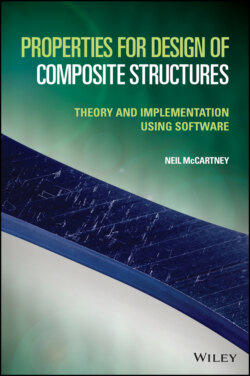Читать книгу Properties for Design of Composite Structures - Neil McCartney - Страница 24
2.9.1 Global Thermodynamic Relations
ОглавлениеIt is essential to understand fully the nature of thermodynamic principles that underpin modelling procedures. It is assumed now that the system studied is multi-component and uniform, and that the temperature and pressure are uniform as would be the case for many equilibrium states of the system. At equilibrium, the classical thermodynamic relations for a uniform multi-component mixture, where Mk,k=1,…,n denote the total masses of the various species, are given by
(2.54)
where U is the internal energy of the system and F and G are the corresponding Helmholtz and Gibbs energies defined by
(2.55)
The brackets {} in (2.54) denote a set of state variables associated with the various species defined for k=1,…,n. The state variables S, T, V and p are the entropy, thermodynamic (i.e. absolute) temperature, volume and pressure, respectively, and the parameters μk,k=1,…,n, are the mass-based chemical potentials. Each of the relations (2.54) defines, for media having uniform state variables and hydrostatic stress states (i.e. in the absence of shear stresses), an equation of state for three different but equivalent selections of the independent state variables. It follows from the three differential relations in (2.54) that
(2.56)
The total mass of the system denoted by M is given by
(2.57)
Any extensive state variable P depends directly on the total M of the system and is such that for any value of the dimensionless parameter λ
(2.58)
On applying this principle to the functions introduced in (2.54)
(2.59)
It follows that the functions U^,F^ or G^ are homogeneous of order unity in the extensive state variables. Provided that λ is independent of the state variables, on differentiating relations (2.59) with respect to λ, and then setting λ=1, it follows on using (2.56) that
(2.60)
The quantities U, F, G, S, V and {Mk} are the extensive variables of uniform multi-component systems used in thermodynamics. The intensive variables, which do not depend on the total mass M of the system, are the temperature T, pressure p and the chemical potentials μk,k=1,…,n. The thermodynamic relations may only be used for uniform systems which are in a state of mechanical and thermal equilibrium. Their use needs to be extended to non-uniform states where gradients of state variables are encountered, and to dynamic states where the various species are subject to motion. In this book, diffusion mechanisms will be neglected, which means that all species at any given location in the material will move with the same velocity v.
